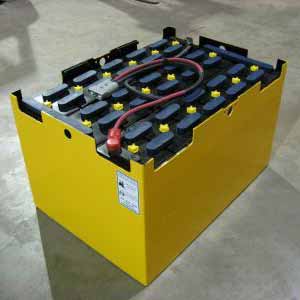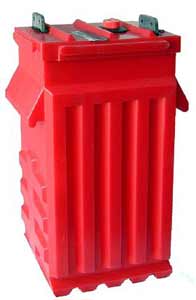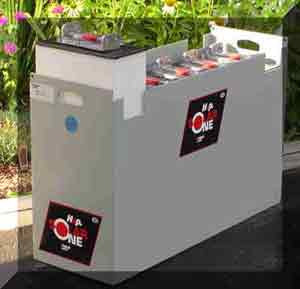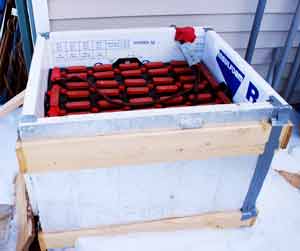
Industrial batteries, also referred to as forklift batteries, are typically the most cost effective storage solution for full-time residences and small businesses that have a moderate to heavy electrical demand. Even though they are great for off-grid applications, they do have some drawbacks that you should consider.
For the renewable energy system, there are three different types/brands of heavy duty batteries to choose from. This is not an exhaustive list, but rather the most common and readily available for renewable energy systems. Below we will be doing a side-by-side comparison of Rolls/Surrette, Solar-One and the common forklift batteries.
ROLLS/SURRETTE

One thing that sticks out as a positive for the Rolls products is their documentation. You can find out any specification about the battery that you would ever need to know – such as number of plates per cell, plate dimensions and expected life in years and cycles. We like this transparent view (not literal) of the battery for comparison but trying to find similar specs on competing products is next to impossible.
SOLAR-ONE
The Solar-One battery with HuP technology is produced by General Battery / EnerSys. Northwest Energy Storage is the primary distributor. The Solar-One looks like a forklift battery tray but with a couple of differences. One, they are not “hard” connected like a typical forklift battery tray but have a bolt-on buss bar. This allows you to easily disconnect and remove any or all of the individual cells. This feature will come in very handy if you do not have the equipment to move a full 3,000 pound forklift tray. The second difference is the DOD (depth of discharge) cycles. They are rated at 2100, 80% DOD cycles which is higher than the typical 1500 cycles of a forklift battery.

General Battery claims the patented HUP or High Utilization Process is the key to long life. Teflon is added to the lead paste used in the active material on the positive plate. This is to stop shedding and flaking of the paste material, which increases lifespan. This is actually more important that you might initially think! Bit by bit the positive plate material will shed off and settle to the bottom of the battery – eventually causing the cells to short.
Another plus for Solar-One is their warranty. We will preface this comment by saying that we have had most interesting dealings with various companies and their claimed warranty of a product. Companies consolidate, go bankrupt and sometimes just plain don’t want to honor their warranties. Because of our personal dealings with “warranty work”, we now look at them as being a nice comfort but they may not have any real meaning at the end of the day. That said, the Solar-One has the best manufacturer warranty of any of the batteries with a full 7 year free replacement and 3 years prorated.
FORKLIFT / PALLET JACK
In comparison to the Solar-One, you can simply get a battery manufactured for a pallet jack or forklift. They may be a little more difficult to handle because they usually are not built with removable, individual cell. The terminals are usually joined with an interconnect called a lead-head. These are soldered onto the terminal but can be cut off and replaced if a cell needs to be removed. A supplier should be able to order a new battery bank with bolt on terminals or uninstalled lead-heads so you can make the connections after it is set into place. However, if you own or have access to a small crane or excavator, this will not be an issue.
Just like most other heavy duty batteries, you will have several different amp-hour sizes to choose from. The largest option is a 48 volt battery tray that can weigh between 2,200 lbs and 3,800 lbs. If you are unable to move that much weight, a better option might be to combine four 12 volt or two 24 volt sets together. This will cut the weight between one quarter and one half, making a more manageable battery bank for installation and subsequent moving or replacement.
Conclusion
Batteries are an unavoidable expense in an off-grid system and pricing out an industrial sized bank will make the word “expense” seem quite expensive. However, looking at the big picture can change your view dramatically. While small batteries may be unavoidable (for various reasons), the industrial sized units are hard to beat when it comes to cost per kilowatt hour.
| Battery Type | Amp Hour Capacity | Cycle Life | Total Battery Cost | Total kWh’s provided at rated DOD* | Lifetime Cost per kWh |
| Rolls S-530 L-16 for comparison | 400 | 1000 @ 50% | $3,000 | 9,600 | $0.31 |
| Rolls 4KS-21PS | 1104 | 3200 @ 50% | $12,420 | 84,787 | $0.15 |
| Solar One -21 | 1055 | 2100 @ 80% | $11,324 | 84,672 | $0.13 |
| Forklift | 1072 | 1500 @ 80% | $4,988 | 61,747 | $0.08 |
Our current forklift batteries.
They are outside with a foam board box and lid built
around them for insulation.

We have used L-16 and golf cart style batteries and currently have a 48 volt battery bank from a forklift that had been wrecked. One key note here is that the forklift battery was not replaced because it worn out but as a result of the forklift being totaled. The difference between our previous battery banks and this one is like night and day.
Performance from a heavily used forklift battery will vary greatly, depending on your application.
Overall, considering the reasonable price of a new forklift battery and the years of service you can expect and the fact that you don’t want to be having to replace a 3,000 lb battery bank every couple of years – a new battery set is hard to beat.
The Solar-One and the Rolls batteries, thought over 60% more expensive per lifetime kilowatt hour, should not be ruled out. They are rated to provide at least 35% more kilowatt hours over their life. That should mean that they would have a calendar lifespan of one third longer. As with anything, keep in mind that these numbers were most likely derived under controlled conditions and are best case examples.
Our preference would be to have one of these heavy duty battery banks over the golf cart or L-16 style if the cost is reasonable. You simply get more for your money in terms of overall life and capacity. We think that a more positive “renewable energy” experience will come with a substantial battery bank. Also, we think there is a slightly better chance that more expensive batteries will also get better care.
What Other Visitors Have Said
Click below to see contributions from other visitors to this page…
Most Lead-acid Batteries are Recycled, not thrown away…
Lead-acid batteries are the most recycled of all types, so most are not wasted. If you’re worried about it, recycle the ones you use. I manage a small …
Alternative to Lead-Acid (Large-Scale Battery Systems)
We need to start talking about how many batteries we are throwing away every year. This is a major problem!!! Iron Edison is redefining off-grid energy …
fork lift battery are poor cousins to the real thing
we come across this quite often forklift battery dressed to look as an industrial deep cycle battery in fact are quite different animals. True deep cycle …
Forklift BAtteries
I use one 48 volt, 3000 lb forklift battery – it is good for storage and cost @ $5000. You must really have a good charging system, able to do 250 amps …
From interstate RV batts to rolls industrial Not rated yet
As a young idealistic engineer out of college I had what I thought was an original motivation for off grid living. Not only for reducing carbon emissions …
reconditioning forklift batteries Not rated yet
powder & pulse recondition systems are not good to solve batteries problem. After service,If works more then 5yrs, those systems are proper way. but …